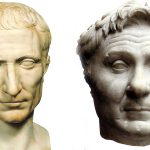The Roman army has evolved many times over the course of history. The equipment (except armour) of Roman soldiers was originally, as was the case in all armies of the then world, on carts or mules/donkeys. Gradually, however, there was a need to improve military mobility, shorten the entire marching column, and abandon the use of too many draft animals and rolling stock.
An important change in the organization of the legions took place during the consulate of Gaius Marius in about 104 BCE. At that time, thanks to Marius, there was the so-called military reform1, which, inter alia, it consisted of convincing soldiers to carry their belongings on constructed wooden forks (furca). The legionary was thus able to carry private packages himself (e.g. tunic, shoes, coat), bags (pera or loculus) with small cooking pots (situale), cake stand, earthmoving tool, tent for contubernium and a few days’ supply of food (cibaria). All said additional luggage determined term sarcina. Interestingly, Cicero in the middle of the 1st century BCE mentions that sometimes the soldiers had to have food sufficient for up to half a month)2. Additionally, Roman soldiers carried mound piles (pila muralis) to separate the camp. These earthmoving tools were rationally distributed among the soldiers; one carried a dolabra, another a shovel, another axe again, another rope, etc. Someone else was supposed to carry the tent. The advantage of this solution was that the soldiers, after reaching the area for the camp, could start earthworks without waiting for the rolling stock.
This relieved and reduced the number of draft animals (sarcinaria iumenta) and increased the mobility of the army. They could move faster off-road without being dependent on the main routes that supply wagons could follow. In addition, legionaries were distinguished by great strength, which gave them an advantage in competition with other armies of antiquity. Such soldiers were mockingly called “Marius’s mules” (muli mariani)3 because a large part of the equipment was transferred from draft animals and carts to the backs of soldiers. It should be added that elements of military and siege machines were transported on carts.
According to the calculations4, Marius’s legionary was probably forced to transport a total of about 55 kg. The weight of weapons, armor and personal equipment alone is about 20 kg. The rest are tools, dishes, food for a few days or shaft piles. It should be noted, however, that the soldier had the right to take a servant (calo) and a draft animal with him, which could additionally relieve him with such a weight. It is assumed that the legionary on his shoulders could carry from 20 to 45 kg of total weight with military equipment, depending on the “support” he had.
Regardless of the weight, the Roman legionary was forced to walk 37.5 km (forced march) or 20 to 25 km (regular march) within 5 hours.
It should be additionally mentioned that the soldiers of Scipio Africanus Aemilianus near Numantia (Spain) in 143 BCE were forced by him to carry a weight of up to 67 kg5. A later Jewish historian Flavius Josephus will mention that “footman hath no great need of a mule to carry his burdens”6.







